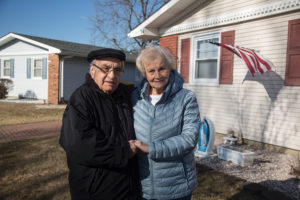
It started shortly after midnight on June 6, 1944. By the end of the day—D-Day—more than 160,000 American, British and Canadian troops had landed on five beaches on the coast of Normandy, France, in the face of relentless German resistance. An additional 24,000 airborne troops landed inland. Casualties were enormous: Among the Allied troops, an estimated 10,000 men were killed, wounded or missing in action after the first day of the Normandy invasion, including more than 6,600 Americans. By late August, the Allies had landed more than 2 million men in northern France, with more than 226,000 casualties. But D-Day gave the Allies the foothold they needed. For 11 more months, they pushed eastward toward Berlin, until Germany surrendered on May 7, 1945. Now, 75 years later, only a handful of Americans from the original D-Day invasion force remain among us. Below, we salute two of those brave men, New Jersey residents who, as young servicemen, put their lives on the line in defense of freedom.
Peter Fantacone
Radioman, USS LCI-492, U.S. Navy
Peter Fantacone was 17 when he joined the Navy in 1943. One year later, the Pennsylvania native had completed his training as a radio operator and was crossing the English Channel in a 158-foot LCI (Landing Craft Infantry) bound for Omaha Beach. The diesel smoke and rough seas were nauseating. “We were bouncing around like a cork,” he recalled in a 2017 interview. As the LCI reached the beach, lines of troops descended its ramps, only to be cut to ribbons by enemy fire. Fantacone remained aboard at his radio as the Americans struggled to gain a foothold on the beach. Offshore, the LCI flotilla was an inviting target for the big German guns. Three LCIs went down in the waters around Fantacone. He recalls watching as LCI-85 capsized, its red-painted bottom sinking beneath the water. That night, as the ships came under air attack, they filled the sky with tracer shells. For Fantacone, a longtime resident of Mays Landing, “it looked like a thousand Fourth of Julys rolled into one.”

Santillo plans to return to Normandy this month for the 75th anniversary commemoration of D-Day.
John Santillo
237th Engineer Combat Batallion, U.S. Army

Santillo at home in Brick with Nina, his longtime companion.
As if the artillery shells and machine-gun bullets weren’t enough, John Santillo had another huge worry as he scrambled off his landing craft into the water off Utah Beach: The 22-year-old Newark native couldn’t swim. All around him, the water was stained with the blood of his comrades. “What I seen coming in looked like the Red Sea,” he tells New Jersey Monthly. Santillo and his fellow combat engineers were assigned to clear a path through mines and other obstacles to help the invasion force advance off the beach. Santillo survived the havoc at Utah Beach and proceeded inland with his battalion, eventually crossing the Rhine River into Germany in spring 1945. Now 96 and living in Brick, he plans to return to Normandy this month, where he will speak at a ceremony in St. Mère Église as part of the 75th anniversary commemoration. It will be his first trip to Normandy since D-Day.
